The Geordie Tour- 5 days cycling around 'Tyne and Wear Metropolitan County' and 'County Durham' (110 miles)
In the second half of the nineteenth century there were typically well over a thousand working collieries in the north east area, by 1913 over 165,000 men and boys laboured in the mining industry around County Durham and Tyne & Wear Metropolitan County. Now, all the pits have gone, leaving behind hundreds of old railway lines. It is this legacy of the old colliery railway lines which allows us to ride from Bishop Auckland to Newcastle. We stay the second night at the Geordie capital, a City famed for it's shipbuilding, and iconic bridges. On the third day we ride past the abandoned and levelled ghost shipyards, visiting Roman remains on both sides of the Tyne, then southerly along the east coast. We go through Sunderland, historically a larger shipbuilding area than Newcastle; at one time Sunderland was said to be the biggest shipbuilding town in the World, now the shadows of its glorious past have all gone replaced in part by the National Glass Centre. On the fourth day we visit the World famous Beamish open air museum before heading back to Bishop Auckland via Durham (a UNESCO World heritage site), hardly ever going on main roads.
Day 1- Newport - Bishop Auckland via Shildon (278 miles- car)
 It’s a tedious four and a half hour drive from Newport to Bishop Auckland where we're due
to start the ride tomorrow. To break up the journey we visited ‘Locomotion’ at Shildon
National Railway Museum a few miles from Bishop Auckland. This is a free museum and is well worth a
visit and would have any train spotter drooling. It has a huge selection of fantastic exhibits, but the place was kind of sterile; there
was not much explanation about the trains and you were unable to see some locos tucked behind others.
After an hour wandering around the Shildon museum, we drove to Bishop Auckland. The scenery
seemed drab, where big factories once stood, now are great swathes of flat concrete wasteland. When we
arrived at the Park Head Country Hotel set in a former 18th century coaching inn, we were weary, and tired
of travel.
It’s a tedious four and a half hour drive from Newport to Bishop Auckland where we're due
to start the ride tomorrow. To break up the journey we visited ‘Locomotion’ at Shildon
National Railway Museum a few miles from Bishop Auckland. This is a free museum and is well worth a
visit and would have any train spotter drooling. It has a huge selection of fantastic exhibits, but the place was kind of sterile; there
was not much explanation about the trains and you were unable to see some locos tucked behind others.
After an hour wandering around the Shildon museum, we drove to Bishop Auckland. The scenery
seemed drab, where big factories once stood, now are great swathes of flat concrete wasteland. When we
arrived at the Park Head Country Hotel set in a former 18th century coaching inn, we were weary, and tired
of travel.
Day 2- Bishop Auckland- Newcastle (45 miles)
There’s a long day ahead today, not so much the millage, there’s just lots to see, but when we left the hotel, it
took us almost fifteen minutes just to cross the busy A688 road to begin the ride. As soon as
we're on ‘Auckland way’, one of the many old ‘Northern Eastern railway’ lines converted
into cycle paths, the traffic noise died and it was peacefull. Shortly we arrive at
Bishop Auckland and with room only at our hotel last night, we headed for a café for tea
and toast. Across the road was the Miners art museum, providing a permanent home for the
renowned ‘Gemini Collection’ of Mining Art. It had just opened and the receptionist was
 happy for us to place the bikes inside, but this was blocked by a burly security guard,
so alas, we didn’t go in. The entrance arch of Auckland castle was just to the right, but
the castle is closed until the end of this year for renovation, so there wasn’t much to
see except for lots of scafolding. The castle (more of a large
house) was official residence, diocesan office, and palace of the Bishop of Durham since
1153. Downhill on a shale path is the deer house, a charming gothic revival built in 1760 to
provide the Bishop’s deer with food and shelter. Next, it would be rude not to visit
Binchester Roman fort (a mile away) founded around 80 AD, it’s up a small steep hill and
past a former hotel and nursing home, now abandoned and almost derelict. Binchester didn't
open until later, so we cheekily hopped over the fence and had a walk around. We couldn’t
see much of the site, as a lot of the museum was in covered buildings, but it was reputed
to be one of the largest Roman military installations in the whole of Northern Britain.
happy for us to place the bikes inside, but this was blocked by a burly security guard,
so alas, we didn’t go in. The entrance arch of Auckland castle was just to the right, but
the castle is closed until the end of this year for renovation, so there wasn’t much to
see except for lots of scafolding. The castle (more of a large
house) was official residence, diocesan office, and palace of the Bishop of Durham since
1153. Downhill on a shale path is the deer house, a charming gothic revival built in 1760 to
provide the Bishop’s deer with food and shelter. Next, it would be rude not to visit
Binchester Roman fort (a mile away) founded around 80 AD, it’s up a small steep hill and
past a former hotel and nursing home, now abandoned and almost derelict. Binchester didn't
open until later, so we cheekily hopped over the fence and had a walk around. We couldn’t
see much of the site, as a lot of the museum was in covered buildings, but it was reputed
to be one of the largest Roman military installations in the whole of Northern Britain.
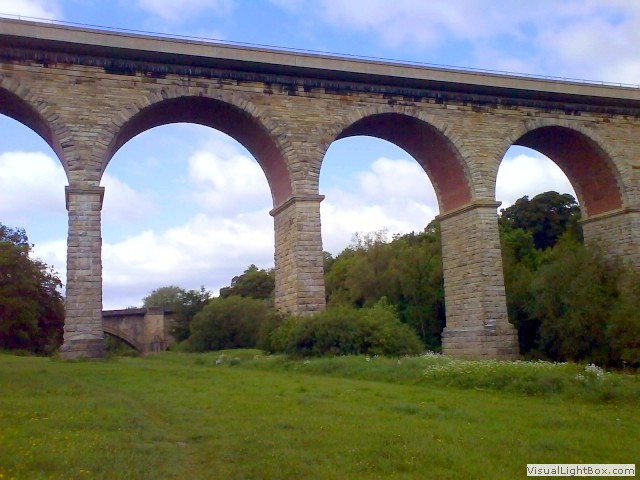 After a 'U' turn from the Roman fort, we ride along the River Wear and under
‘Newton Cap Viaduct’. Towering over us, this ten stone arch viaduct once carried
the Northern Eastern railway across the river, when the axe fell (and several years later), the bold
highway builders put a wider concrete top on it and built a tarmac road across it. The fact
it was suitable to do this, is a testament to the Victorian engineers that built it.
We double back on ourselves and cross the mighty viaduct, then onto the Bishop Auckland
Railway Path. At Brancepeth ten miles from Bishop Auckland, it’s another diversion from the cycle
path to see Brancepeth castle. Spotlessly clean, it looked brand new, and unblemished,
leading me to the conclusion that either this wasn’t an original Norman castle or it has
been recently (historically speaking) been rebuilt, but it is a spectacle
to see. Back on the track bed we crossed loads of roads as all the bridges had been removed
making quite a disjointed ride. At ‘Neville’s Cross’, there was a major railway junction where we
currently parallel the main line railway and proceed on the ‘Lanchester valley Walk’.
Eighteen miles from Bishop Auckland is Langley where the famous Durham Gin Distillery
resides. The route now loosely follows the River Browney and continues gently
uphill, past a few railway stations subtly disguised as private residences. The path goes
through Lanchester, and we feel it’s worth mentioning ‘Kaffeehaus Amadeus’, a café with over twenty
different coffees. I had an Indian coffee, nutty, and strong and I never even knew the
country produced coffee.
After a 'U' turn from the Roman fort, we ride along the River Wear and under
‘Newton Cap Viaduct’. Towering over us, this ten stone arch viaduct once carried
the Northern Eastern railway across the river, when the axe fell (and several years later), the bold
highway builders put a wider concrete top on it and built a tarmac road across it. The fact
it was suitable to do this, is a testament to the Victorian engineers that built it.
We double back on ourselves and cross the mighty viaduct, then onto the Bishop Auckland
Railway Path. At Brancepeth ten miles from Bishop Auckland, it’s another diversion from the cycle
path to see Brancepeth castle. Spotlessly clean, it looked brand new, and unblemished,
leading me to the conclusion that either this wasn’t an original Norman castle or it has
been recently (historically speaking) been rebuilt, but it is a spectacle
to see. Back on the track bed we crossed loads of roads as all the bridges had been removed
making quite a disjointed ride. At ‘Neville’s Cross’, there was a major railway junction where we
currently parallel the main line railway and proceed on the ‘Lanchester valley Walk’.
Eighteen miles from Bishop Auckland is Langley where the famous Durham Gin Distillery
resides. The route now loosely follows the River Browney and continues gently
uphill, past a few railway stations subtly disguised as private residences. The path goes
through Lanchester, and we feel it’s worth mentioning ‘Kaffeehaus Amadeus’, a café with over twenty
different coffees. I had an Indian coffee, nutty, and strong and I never even knew the
country produced coffee.
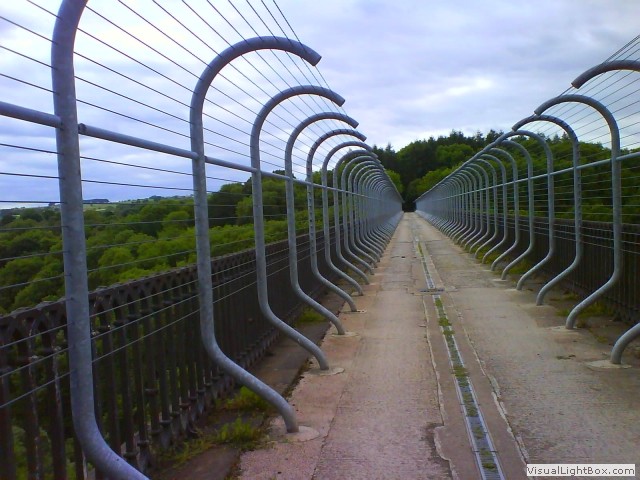 Twenty five miles from the start gets us to the outskirts of ‘Concett’ where we turn
south west to see the ‘Hownsgill Viaduct’. Another Victorian bridge which only shut to
trains in the late eighties, but today it’s more infamous for people jumping off it,
than it was for trains going over it; there was one suicide from the bridge every two weeks in the
first half of 2011 and more fatalities in 2012. In 2013 the authorities had enough, and fitted
anti-suicide fences to the bridge. We head north at Lygett's Junction and skirt around
the northern edge of Concett. We are now riding on the footprints of a massive steelworks
which closed in the 1980’s, the last steel ingot from Consett steelworks was made into a cross
and is kept at St Mary's Roman Catholic Church, Blackhill. The rain spat at us while
we made our way downhill through the wooded Derwent valley, crossing a few of viaducts. At Swalwell
we turn east and head towards Gateshead passing a huge curved wooden jetty. Dunston
Staiths were built in 1893 to allow large quantities of coal arriving by rail from the Durham
Coalfields to be loaded directly onto waiting colliers (coal ships). Finally we cross
the River Tyne on a swing bridge and head east passing near the ‘King Edward VII railway
bridge’, and the iconic ‘Tyne Bridge’. Over the river in Gateshead is what looks like
a great silver winnebago, it's the ‘Sage’; a
performance venue surely as identifiable as the ‘Sydney Opera House’. The second nights
stop is in a humble ‘Travelodge ©’ booked a year in advance for the bargain price
of £39. It was a long hard day today, with the temperature changing from 16°C
to 21°C, I finished with my head burnt to a crisp. We ate at ‘Aneesa's’ an all-you-can-eat
Indian buffet, and we felt we deserved to eat until our bellies hurt, but of course there
isn’t any justification for gluttony, nevertheless it was a great place to eat.
Twenty five miles from the start gets us to the outskirts of ‘Concett’ where we turn
south west to see the ‘Hownsgill Viaduct’. Another Victorian bridge which only shut to
trains in the late eighties, but today it’s more infamous for people jumping off it,
than it was for trains going over it; there was one suicide from the bridge every two weeks in the
first half of 2011 and more fatalities in 2012. In 2013 the authorities had enough, and fitted
anti-suicide fences to the bridge. We head north at Lygett's Junction and skirt around
the northern edge of Concett. We are now riding on the footprints of a massive steelworks
which closed in the 1980’s, the last steel ingot from Consett steelworks was made into a cross
and is kept at St Mary's Roman Catholic Church, Blackhill. The rain spat at us while
we made our way downhill through the wooded Derwent valley, crossing a few of viaducts. At Swalwell
we turn east and head towards Gateshead passing a huge curved wooden jetty. Dunston
Staiths were built in 1893 to allow large quantities of coal arriving by rail from the Durham
Coalfields to be loaded directly onto waiting colliers (coal ships). Finally we cross
the River Tyne on a swing bridge and head east passing near the ‘King Edward VII railway
bridge’, and the iconic ‘Tyne Bridge’. Over the river in Gateshead is what looks like
a great silver winnebago, it's the ‘Sage’; a
performance venue surely as identifiable as the ‘Sydney Opera House’. The second nights
stop is in a humble ‘Travelodge ©’ booked a year in advance for the bargain price
of £39. It was a long hard day today, with the temperature changing from 16°C
to 21°C, I finished with my head burnt to a crisp. We ate at ‘Aneesa's’ an all-you-can-eat
Indian buffet, and we felt we deserved to eat until our bellies hurt, but of course there
isn’t any justification for gluttony, nevertheless it was a great place to eat.
Day 3- Newcastle- Beamish (39 miles)
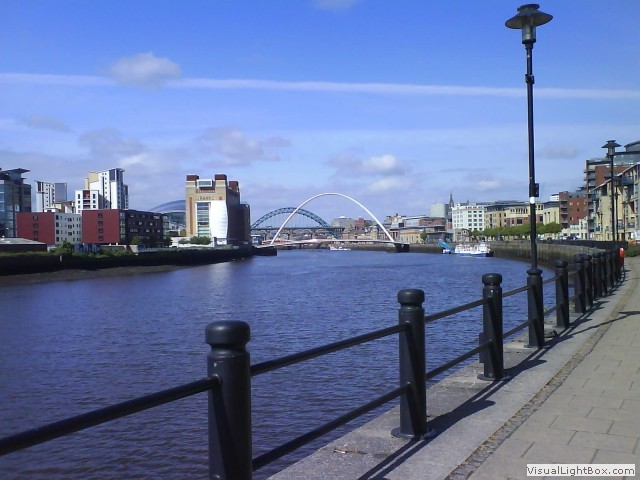 From the hotel we went north just ¼ a mile to see the ‘Holy Jesus Hospital’ a small
building built on the foundations of an Augustinian friary, it became a hospital and
was in use for 700 years, but blink and you’d miss it. We now proceed along the river by
the Gateshead Millennium Bridge a massive cantilever pedestrian arch across
the river then onto ‘Hadrian’s Way’ past the old ship building yards. One thing that
struck us riding along the Tyne was the abundance of wild flowers, there were loads
we’d never seen before. With no more than five miles from our departure, we come across Segedunum; a
Roman fort and settlement. It’s incredible to think for centuries the area was open
farmland, then in the late 19th century, collieries were sunk near the fortification,
and gradually the whole fort disappeared under terraced housing. The site was excavated
in 1997, then construction of a replica bath house followed and conversion of the former Swan
Hunter shipyard buildings to house a new museum. For us, it’s like we discovered
Segedunum for the first time while riding past it- well worth a visit.
From the hotel we went north just ¼ a mile to see the ‘Holy Jesus Hospital’ a small
building built on the foundations of an Augustinian friary, it became a hospital and
was in use for 700 years, but blink and you’d miss it. We now proceed along the river by
the Gateshead Millennium Bridge a massive cantilever pedestrian arch across
the river then onto ‘Hadrian’s Way’ past the old ship building yards. One thing that
struck us riding along the Tyne was the abundance of wild flowers, there were loads
we’d never seen before. With no more than five miles from our departure, we come across Segedunum; a
Roman fort and settlement. It’s incredible to think for centuries the area was open
farmland, then in the late 19th century, collieries were sunk near the fortification,
and gradually the whole fort disappeared under terraced housing. The site was excavated
in 1997, then construction of a replica bath house followed and conversion of the former Swan
Hunter shipyard buildings to house a new museum. For us, it’s like we discovered
Segedunum for the first time while riding past it- well worth a visit.
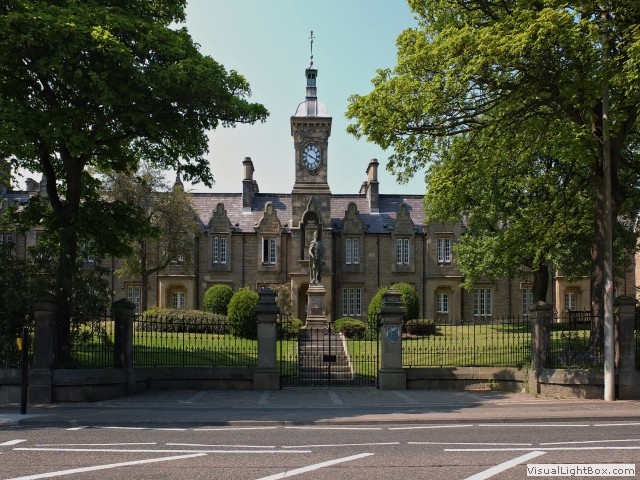 We ride under the Willington viaduct and head east towards Tynemouth Castle and pass
the ‘Master Mariners' Homes’, these were Almshouses, built in 1837 in a Jacobean
style originally for the Tyne Mariners’ Benevolent Institution, with the then Duke
of Northumberland’s statue (as he donated the land) standing in front of an impressive clock
tower. Finally we can’t ride any further east, as high on a spit of land is Tynemouth
Castle, combined with the ruins of the Benedictine priory where early Kings of
Northumbria were buried. It’s £5.70 to enter through the gatehouse towers
and through the bailey into open space, then you can see the priory ruins. It’s
such an odd place walking between hundreds of graves, eerily quiet except for
the sea down below crashing against the rocks. It’s an obvious location for a
military battery to defend the River Tyne, and there's been a garrison here since
Napoleonic times. Today there’s remains of a WW2 guardroom and an armoury, and the gun emplacement
is a formidable reproduction. We rode back along the river mouth past the ‘Life Brigade Watch
House’ (a predecessor to our modern day Coastguard) and to the North Shields
ferry quayside. We asked a man painting a house when the next ferry was? His reply
was somewhat unexpected; "Yee divvent want te gan sooth o the river son, the Mackems
live ower there," (in a Geordie voice). We later found out 'Mackems' are people
from Sunderland, I guess the chap was a Newcastle football supporter.
We ride under the Willington viaduct and head east towards Tynemouth Castle and pass
the ‘Master Mariners' Homes’, these were Almshouses, built in 1837 in a Jacobean
style originally for the Tyne Mariners’ Benevolent Institution, with the then Duke
of Northumberland’s statue (as he donated the land) standing in front of an impressive clock
tower. Finally we can’t ride any further east, as high on a spit of land is Tynemouth
Castle, combined with the ruins of the Benedictine priory where early Kings of
Northumbria were buried. It’s £5.70 to enter through the gatehouse towers
and through the bailey into open space, then you can see the priory ruins. It’s
such an odd place walking between hundreds of graves, eerily quiet except for
the sea down below crashing against the rocks. It’s an obvious location for a
military battery to defend the River Tyne, and there's been a garrison here since
Napoleonic times. Today there’s remains of a WW2 guardroom and an armoury, and the gun emplacement
is a formidable reproduction. We rode back along the river mouth past the ‘Life Brigade Watch
House’ (a predecessor to our modern day Coastguard) and to the North Shields
ferry quayside. We asked a man painting a house when the next ferry was? His reply
was somewhat unexpected; "Yee divvent want te gan sooth o the river son, the Mackems
live ower there," (in a Geordie voice). We later found out 'Mackems' are people
from Sunderland, I guess the chap was a Newcastle football supporter.
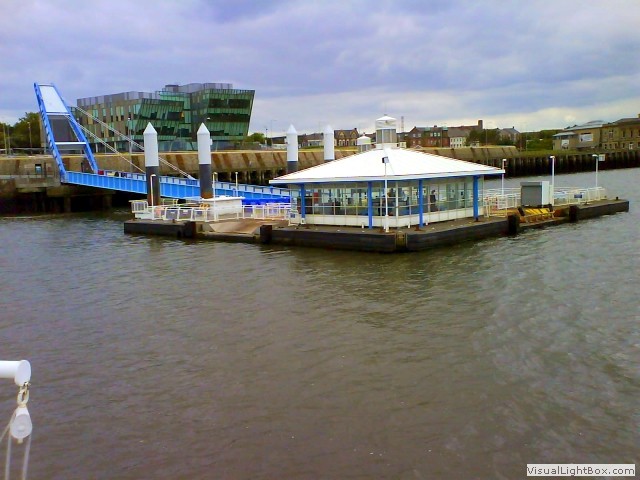 We didn’t have to wait long for the next boat and crossed the River Tyne. It’s a short
ride from here to the ‘Arbeia Roman Fort’, the gate house has been partially
reconstructed, but the rest is a ruin. It’s another free entry and we spent thirty
minutes walking around the Roman Fort. Downhill from here we met the North Sea, and
I never knew South Shields had a beach front, we had the traditional donuts and
moved on. We come across Souter Lighthouse, built in 1871, Souter was the first lighthouse
in the World purpose built to use electricity. We passed a 'Whitburn Colliery' plaque
on a wall, Whitburn Coal Company sunk two shafts south of the lighthouse between 1874 and
1877 reaching an incredible ten miles out under the sea. A short distance after ‘Whitburn Windmill’
We didn’t have to wait long for the next boat and crossed the River Tyne. It’s a short
ride from here to the ‘Arbeia Roman Fort’, the gate house has been partially
reconstructed, but the rest is a ruin. It’s another free entry and we spent thirty
minutes walking around the Roman Fort. Downhill from here we met the North Sea, and
I never knew South Shields had a beach front, we had the traditional donuts and
moved on. We come across Souter Lighthouse, built in 1871, Souter was the first lighthouse
in the World purpose built to use electricity. We passed a 'Whitburn Colliery' plaque
on a wall, Whitburn Coal Company sunk two shafts south of the lighthouse between 1874 and
1877 reaching an incredible ten miles out under the sea. A short distance after ‘Whitburn Windmill’
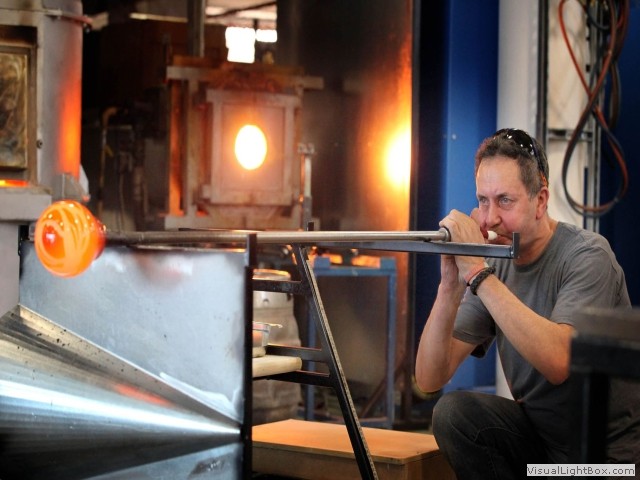 we arrive at Sunderland and turn west following the ‘River Wear’. We dropped into the 'National
Glass Centre' for an hour and watched two amazing demos by talented glass artists. Seeing
glass being turned on a lathe and blown was a sight to behold. Sunderland is also famous for
its shipbuilding, once dubbed 'the largest shipbuilding town in the World', all closed by the
mid 1980’s. We crossed the river on the Wearmouth bridge (Sunderland’s equivalent of the Tyne bridge)
and followed the River Wear on the south side on another old
Northern Eastern railway path. Turning off the path at Coxgreen, you can just see the Penshaw Victorian
folly, a replica of an ancient Greek temple, high on the hill. We re-cross the River Wear near
the pub, ‘the Oddfellows Arms’ and follow the ‘Consett & Sunderland railway'
(the C2C) path all the way to Beamish Best Western hotel, our third stop for the night.
we arrive at Sunderland and turn west following the ‘River Wear’. We dropped into the 'National
Glass Centre' for an hour and watched two amazing demos by talented glass artists. Seeing
glass being turned on a lathe and blown was a sight to behold. Sunderland is also famous for
its shipbuilding, once dubbed 'the largest shipbuilding town in the World', all closed by the
mid 1980’s. We crossed the river on the Wearmouth bridge (Sunderland’s equivalent of the Tyne bridge)
and followed the River Wear on the south side on another old
Northern Eastern railway path. Turning off the path at Coxgreen, you can just see the Penshaw Victorian
folly, a replica of an ancient Greek temple, high on the hill. We re-cross the River Wear near
the pub, ‘the Oddfellows Arms’ and follow the ‘Consett & Sunderland railway'
(the C2C) path all the way to Beamish Best Western hotel, our third stop for the night.
Day 4- Beamish Museum
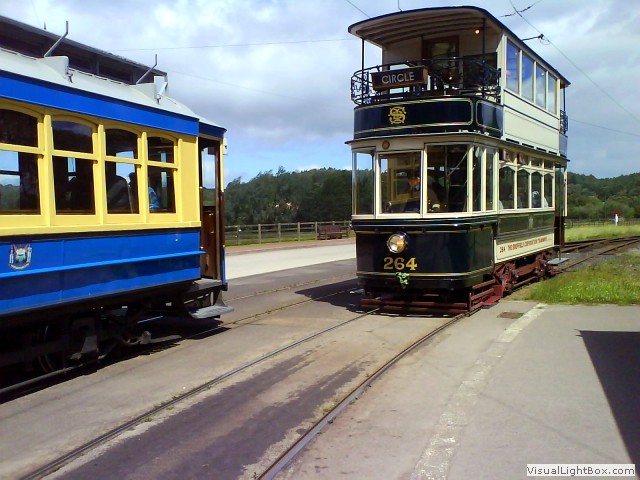 Beamish is an open-air museum located near the town of Stanley. The museum's guiding principle
is to preserve an example of everyday life in urban and rural North East England at the climax
of industrialisation in the early 20th century. Much of the restoration and interpretation is
specific to the late Victorian and Edwardian eras, together with portions of countryside under
the influence of industrial revolution in 1825. On its massive site there are original, and
replica buildings, a huge collection of artifacts, working vehicles, and equipment; as well
Beamish is an open-air museum located near the town of Stanley. The museum's guiding principle
is to preserve an example of everyday life in urban and rural North East England at the climax
of industrialisation in the early 20th century. Much of the restoration and interpretation is
specific to the late Victorian and Edwardian eras, together with portions of countryside under
the influence of industrial revolution in 1825. On its massive site there are original, and
replica buildings, a huge collection of artifacts, working vehicles, and equipment; as well
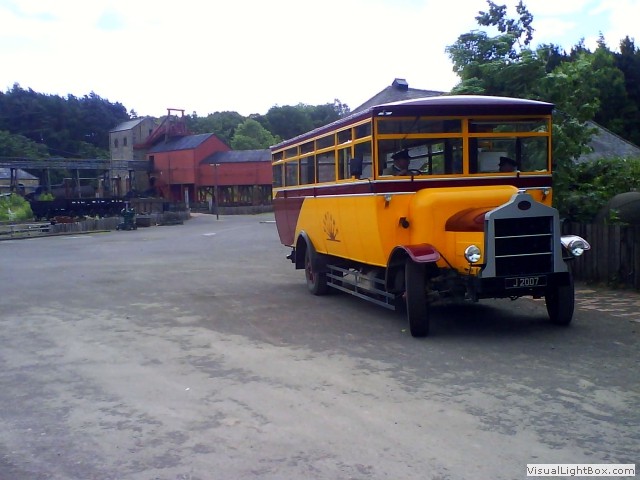 as livestock and costumed interpreters. Well that’s the official version of Beamish. The
only original features of Beamish are; the drift mine, Pockerley Old Hall, and the
farm, but unless you knew that, you wouldn’t be able to tell all the other sections are a reproduction. The
different parts of the museum are spread out over a gigantic area, a fair old distance to cover
if on foot. However, the beauty is that there are bus stops and tram stops conveniently placed everywhere.
The tram goes around in a huge circle and where the tram can't get to- there are vintage buses to
take you around. Period dressed staff are at each attraction, and it is they who bring the museum to life with their
stories of real people long since departed. It gives you a sense of awe, and really was like
taking a step back in time. Beamish museum continues to expand (and has the land to achieve it) with
a 1950’s village in the making. This is the third open-air museum I’ve been to in the UK. The
others were; Blists Hill Victorian Town and Crich Tramway Village. It’s difficult to
favouritise which one is better as each have slightly different attributes, but if I had
to; it would be Blists Hill. Would I go back to Beamish? No, only because there are others to see in
the UK; Amberley Museum and Heritage Centre at Arundel and the Black Country Living Museum
Dudley, West Midlands, to name but two.
as livestock and costumed interpreters. Well that’s the official version of Beamish. The
only original features of Beamish are; the drift mine, Pockerley Old Hall, and the
farm, but unless you knew that, you wouldn’t be able to tell all the other sections are a reproduction. The
different parts of the museum are spread out over a gigantic area, a fair old distance to cover
if on foot. However, the beauty is that there are bus stops and tram stops conveniently placed everywhere.
The tram goes around in a huge circle and where the tram can't get to- there are vintage buses to
take you around. Period dressed staff are at each attraction, and it is they who bring the museum to life with their
stories of real people long since departed. It gives you a sense of awe, and really was like
taking a step back in time. Beamish museum continues to expand (and has the land to achieve it) with
a 1950’s village in the making. This is the third open-air museum I’ve been to in the UK. The
others were; Blists Hill Victorian Town and Crich Tramway Village. It’s difficult to
favouritise which one is better as each have slightly different attributes, but if I had
to; it would be Blists Hill. Would I go back to Beamish? No, only because there are others to see in
the UK; Amberley Museum and Heritage Centre at Arundel and the Black Country Living Museum
Dudley, West Midlands, to name but two.
Day 5- Beamish to Bishop Auckland (27 miles)
After visiting Beamish Museum yesterday, it’s back on the bike again today heading west. Though
we’re on an old railway track, there are loads of new bridges crossing over the
main roads and we’re very grateful for time, effort, and money to build these.
We ride through ‘Stanley’ on the C2C cycle route (the Consett and Sunderland
railway path) and leave the path at Annfield Plain and onto Howden road to rejoin
the cycle path at Lanchester cutting a horseshoe of eight miles out of the return journey. We’re back on the
route from the first day, through Langley Park, but leave the cycle path once again at
Bearpark heading for Durham. Down Redhills lane was St Nicholas burial ground with six
Commonwealth war graves, four from WW1 and two from WW2. Inside the graveyard were three elderly men
voluntarily clearing the wild foliage, the cemetery had become denigrated, unkempt, and overgrown
for decades. The chaps had been working on it for over twelve months and did have ‘community
payback’ people helping them at one stage, but the funding was withdrawn (what the
hell does that mean, isn’t this what the naughty people are supposed to be doing?). We continued
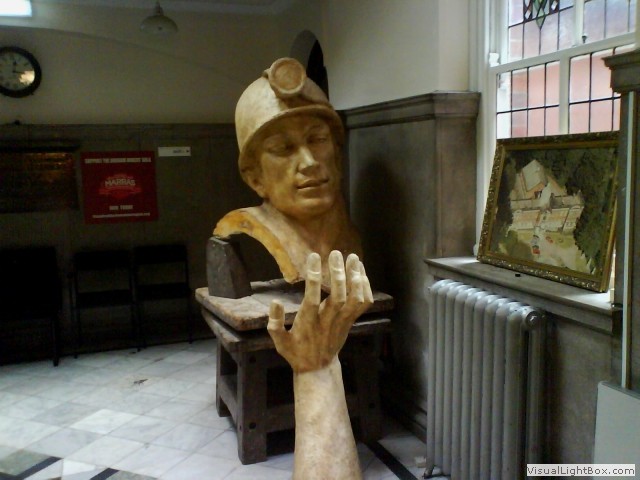 riding down the lane and came across the ‘National Union of Mineworkers’ (NUM)
headquarters. We took a chance and went in, we were lucky the security guard showed us around,
inside the hall seats were grouped around like an auditorium with each chair numbered,
this is where each Union mine leader would sit. Quiet now, but I would have liked to
be a fly on the wall during the pit closures of the eighties. It’s through a series
of one way streets to cross the River Wear on ‘Framwellgate
Bridge’, re-built in the 14th-century. We walked from here up the hill, with
the massive silhouette of Durham castle masking the sky, through Silver street
and then Saddler street past modern shops in old buildings to the ‘Durham
World Heritage Site Visitor Centre’, housed in a refurbished 19th century almshouse.
riding down the lane and came across the ‘National Union of Mineworkers’ (NUM)
headquarters. We took a chance and went in, we were lucky the security guard showed us around,
inside the hall seats were grouped around like an auditorium with each chair numbered,
this is where each Union mine leader would sit. Quiet now, but I would have liked to
be a fly on the wall during the pit closures of the eighties. It’s through a series
of one way streets to cross the River Wear on ‘Framwellgate
Bridge’, re-built in the 14th-century. We walked from here up the hill, with
the massive silhouette of Durham castle masking the sky, through Silver street
and then Saddler street past modern shops in old buildings to the ‘Durham
World Heritage Site Visitor Centre’, housed in a refurbished 19th century almshouse.
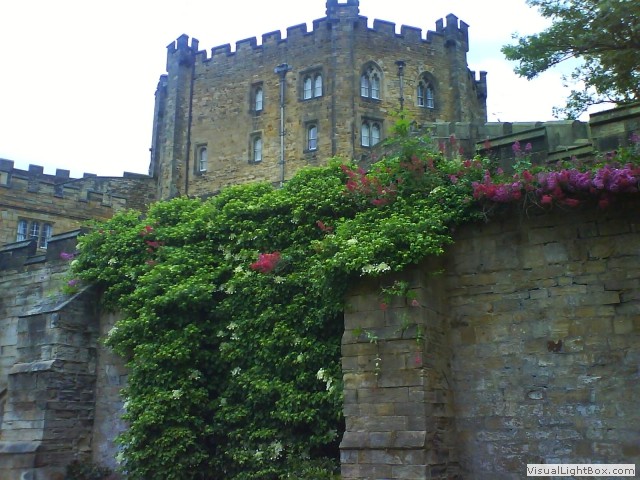 There are not many official places to lock the bike, but we found the university
'police lodge' and with permission, we stowed the bikes there (at one stage the
Durham security lodge was manned with real police, but now it's manned with by a
private security company). We went on a tour of the
castle, but the great hall was closed. The tour guides are students from the
university and seemed enthusiastic about being there. There
are places off limits due to the university use, but it’s defiantly worth a visit.
After an hour here it’s on to the Cathedral, just one hundred yards away. I’m not
religious in the slightest, but one can’t help be drawn into the magnificence
of the size of this building, but I failed to see why Durham Cathedral has
officially been named the UK’s most popular cathedral. We re-crossed the
River Wear this time on the ‘Prebends bridge’, probably Durham's most 'visited'
bridge, offering views of the Cathedral and wooded riverbanks.
We head back to ‘Lanchester Valley Walk’ cycle path to proceed towards Bishop
Auckland, and meet back up with it at
‘Nevilles Crossbank’, continuing on the old railway line for a few miles
before coming off again at Brancepeth, where we join Whitworth lane across
There are not many official places to lock the bike, but we found the university
'police lodge' and with permission, we stowed the bikes there (at one stage the
Durham security lodge was manned with real police, but now it's manned with by a
private security company). We went on a tour of the
castle, but the great hall was closed. The tour guides are students from the
university and seemed enthusiastic about being there. There
are places off limits due to the university use, but it’s defiantly worth a visit.
After an hour here it’s on to the Cathedral, just one hundred yards away. I’m not
religious in the slightest, but one can’t help be drawn into the magnificence
of the size of this building, but I failed to see why Durham Cathedral has
officially been named the UK’s most popular cathedral. We re-crossed the
River Wear this time on the ‘Prebends bridge’, probably Durham's most 'visited'
bridge, offering views of the Cathedral and wooded riverbanks.
We head back to ‘Lanchester Valley Walk’ cycle path to proceed towards Bishop
Auckland, and meet back up with it at
‘Nevilles Crossbank’, continuing on the old railway line for a few miles
before coming off again at Brancepeth, where we join Whitworth lane across
 the River Wear and now into ‘Stanners Lane’. It's time for a tea at ‘Whiteworth
Hall and Country Park’, the park includes a Grade II listed
stately mansion (the ancestral home of an 18th-century MP), a deer
park, and a Victorian walled garden which allegedly contains England's most northerly
vineyard. You can pay to feed the deer’s and I watched a man do that, I
couldn’t believe how cheeky these animals were, butting the man for more. Now,
we turn west onto ‘Aukland Way’ back to the start of our
adventure to pick the car up.
the River Wear and now into ‘Stanners Lane’. It's time for a tea at ‘Whiteworth
Hall and Country Park’, the park includes a Grade II listed
stately mansion (the ancestral home of an 18th-century MP), a deer
park, and a Victorian walled garden which allegedly contains England's most northerly
vineyard. You can pay to feed the deer’s and I watched a man do that, I
couldn’t believe how cheeky these animals were, butting the man for more. Now,
we turn west onto ‘Aukland Way’ back to the start of our
adventure to pick the car up.
The weather man never predicts more than two days in advance anymore and our week was as inconsistent as the next, it ranged between 16°C and 21°C and was mostly overcast. The journey up was long, but broken up by visiting the National railway museum at Shildon. Roman influence around the area is substantial, during the construction of Hadrian’s Wall their numbers grew and remained at that level for around two hundred years. We saw four castles, but two were clearly fortified homes and Brancepeth castle was strange, it just looked so new, that said they’re still worth visiting and are very interesting. It’s not fair to highlight any single attraction at the Beamish museum, because they are all credible and unique in their own way, though personally Mahogany mine was my favourite. We were quietly disappointed with Durham cathedral (as it was named as one of the best in the UK), but loved the National Miners hall and Commonwealth graves in Durham. It was a great few days cycling and sightseeing in the area, the people were very friendly, and the traffic was excellent; on the road everyone gave us room and were courteous. It was on the Swansea ride last year where we met a man who suggested cycling around the Tyne and Wear area and I’m glad we heeded his recommendation. What a great few days away.
-
Gallery
 Why not have a look at the gallery relating to this ride. Click the image or the title.
Why not have a look at the gallery relating to this ride. Click the image or the title. -
Stockton and Darlington Railway
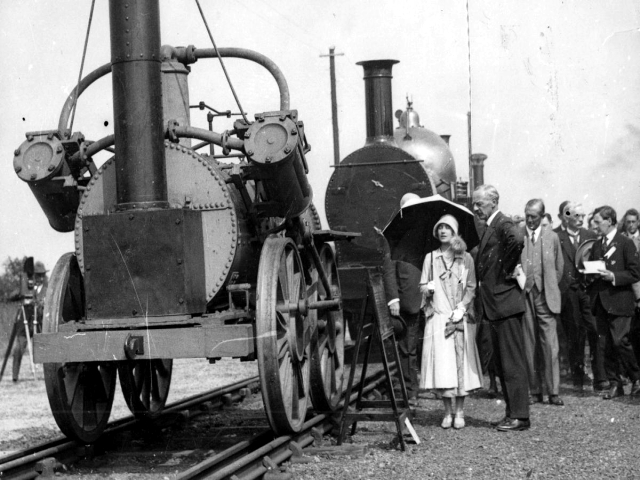 The world's first passenger railway; the Stockton and Darlington Railway opened
in 1825 with a train hauled by Locomotion No 1 which took two hours to complete the
twelve mile journey from Shildon to Darlington.
The world's first passenger railway; the Stockton and Darlington Railway opened
in 1825 with a train hauled by Locomotion No 1 which took two hours to complete the
twelve mile journey from Shildon to Darlington. -
The Gemini Collection
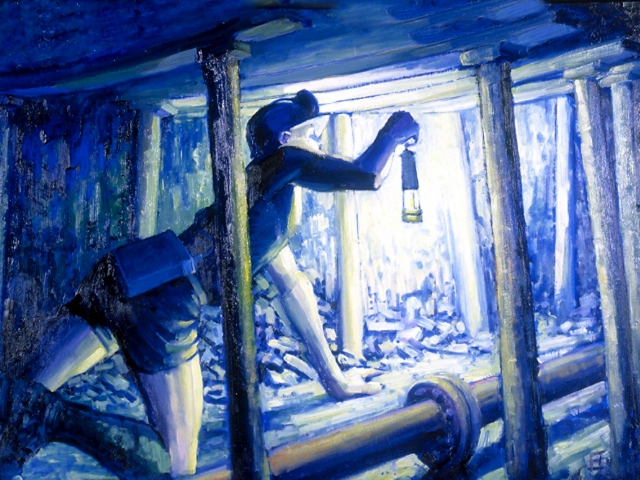 The Gemini Collection of Mining Art includes more than 420 works by prominent
local artists. The art shows what it felt like to work in the coalmines and shed
light on why some miners felt it necessary to paint the dark, clamorous,
claustrophobic, and arcane world of a coal mine.
The Gemini Collection of Mining Art includes more than 420 works by prominent
local artists. The art shows what it felt like to work in the coalmines and shed
light on why some miners felt it necessary to paint the dark, clamorous,
claustrophobic, and arcane world of a coal mine. -
Binchester Roman fort
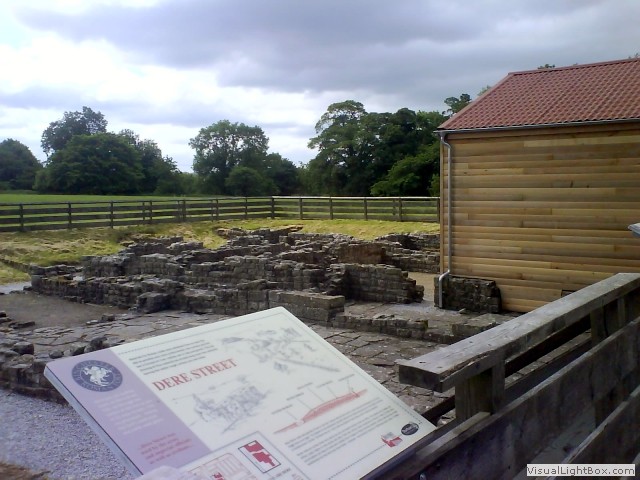 Known from inscriptions on tablets, the garrison in this fort was a cavalry unit originally
recruited from central Spain accompanied at some point by a unit of cavalry originating
from the area we now know as Holland.
Known from inscriptions on tablets, the garrison in this fort was a cavalry unit originally
recruited from central Spain accompanied at some point by a unit of cavalry originating
from the area we now know as Holland. -
Brancepeth castle
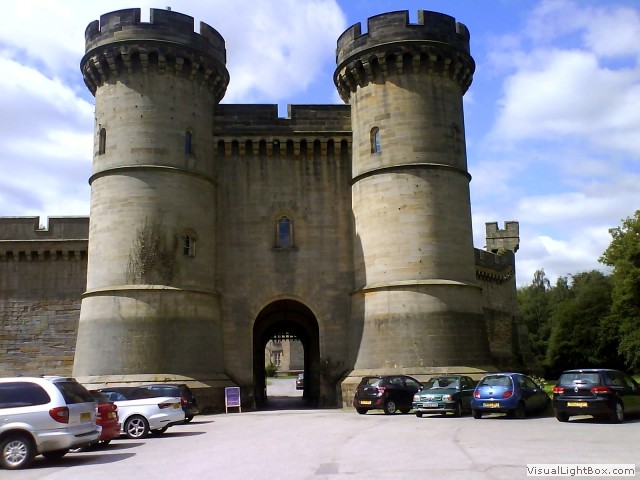 The present building is largely a 19th-century restoration carried out in the 1820s.
During the WW1 the castle was used as a hospital by convalescents from Newcastle
General Hospital. In 1939 it became the regimental headquarters for the Durham Light
Infantry, who erected a military camp of over 100 huts to the south of the village
during WW2. The Durham Light Infantry left the Castle in 1962.
The present building is largely a 19th-century restoration carried out in the 1820s.
During the WW1 the castle was used as a hospital by convalescents from Newcastle
General Hospital. In 1939 it became the regimental headquarters for the Durham Light
Infantry, who erected a military camp of over 100 huts to the south of the village
during WW2. The Durham Light Infantry left the Castle in 1962. -
The Consett Steelworks
 The sky over Consett, had long been famous for its thick haze of red iron oxide
dust thrown up by the steelworks, as was the cloud of steam evaporating all around
the tall cooling towers, but the price for cleaner air was high. Amidst intense
debate and large demonstrations by workers and sympathizers, Consett Steel Works
was closed in 1980, leading to massive job losses, but the true reflection of unemployment and social
impact couldn’t be calculated because of all the support industries lost.
The sky over Consett, had long been famous for its thick haze of red iron oxide
dust thrown up by the steelworks, as was the cloud of steam evaporating all around
the tall cooling towers, but the price for cleaner air was high. Amidst intense
debate and large demonstrations by workers and sympathizers, Consett Steel Works
was closed in 1980, leading to massive job losses, but the true reflection of unemployment and social
impact couldn’t be calculated because of all the support industries lost. -
Dunston Staiths
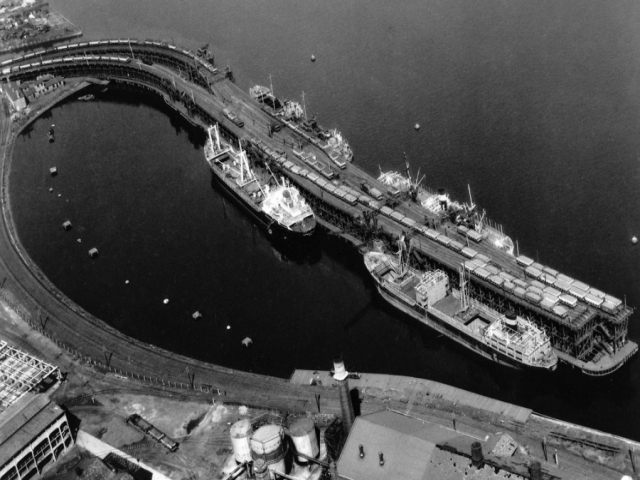 As the coal industry declined during the latter part of last the century, so too did Dunston
Staiths, the jetty eventually fell into serious disrepair. Though some reprieve came
when the National Garden Festival was held in Gateshead in 1990, some repairs were
done and it became a grade II listed structure.
As the coal industry declined during the latter part of last the century, so too did Dunston
Staiths, the jetty eventually fell into serious disrepair. Though some reprieve came
when the National Garden Festival was held in Gateshead in 1990, some repairs were
done and it became a grade II listed structure. -
Swan Hunter Shipyard
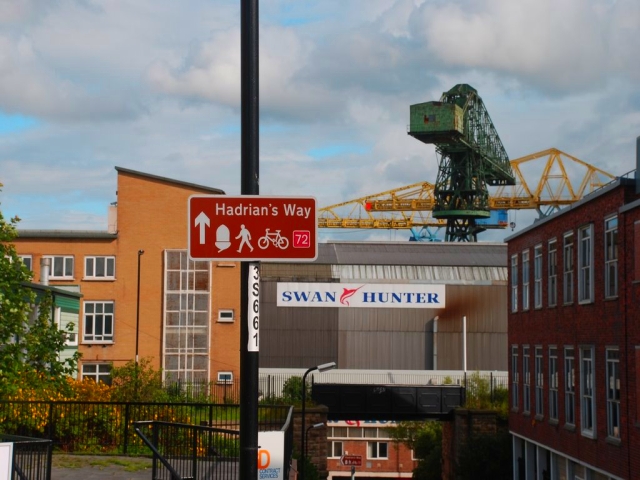 In the 19th century, shipbuilding and heavy engineering were central to the
city's prosperity. The shipyards employed generations of families, today only one
small shipbuilder still exists. Swan Hunter was the biggest shipbuilder in Newcastle,
launching famous ships including the Mauretania, and the Carpathia in 1912 (which
braved icebergs to rescue the survivors of the Titanic). The city was a
powerhouse of the Industrial Revolution, by 1800 Tyneside was the third largest
producer of ships in Britain. In May 1993 the receivers were called in and job
losses of over 2,000 were announced at the Swan Hunter yards.
In the 19th century, shipbuilding and heavy engineering were central to the
city's prosperity. The shipyards employed generations of families, today only one
small shipbuilder still exists. Swan Hunter was the biggest shipbuilder in Newcastle,
launching famous ships including the Mauretania, and the Carpathia in 1912 (which
braved icebergs to rescue the survivors of the Titanic). The city was a
powerhouse of the Industrial Revolution, by 1800 Tyneside was the third largest
producer of ships in Britain. In May 1993 the receivers were called in and job
losses of over 2,000 were announced at the Swan Hunter yards. -
Tynemouth Priory
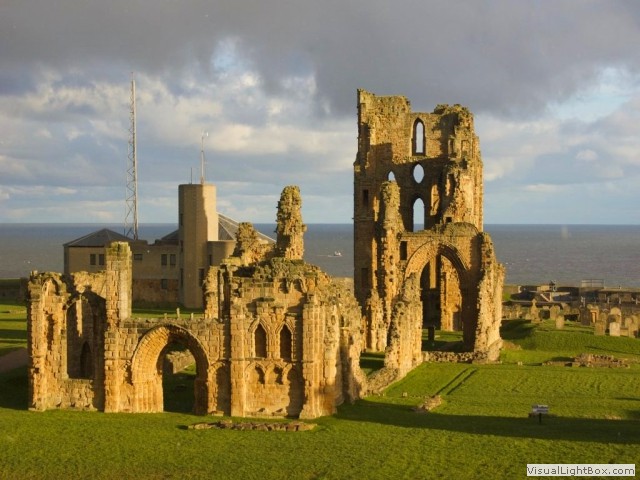 The Priory was sacked by the Danes several times, despite fortification by the monks. Time has left behind its spiritual
scars and those brave enough to walk through the Castle and Priory after dark may
catch sight of the Black Monk, who is said to roam the grounds in his hooded robes. Even
in daylight it’s quite odd walking amongst the graves, and despite the spit of land being
open, you can clearly hear people speaking on the other side of the site.
The Priory was sacked by the Danes several times, despite fortification by the monks. Time has left behind its spiritual
scars and those brave enough to walk through the Castle and Priory after dark may
catch sight of the Black Monk, who is said to roam the grounds in his hooded robes. Even
in daylight it’s quite odd walking amongst the graves, and despite the spit of land being
open, you can clearly hear people speaking on the other side of the site. -
Arbeia Roman Fort
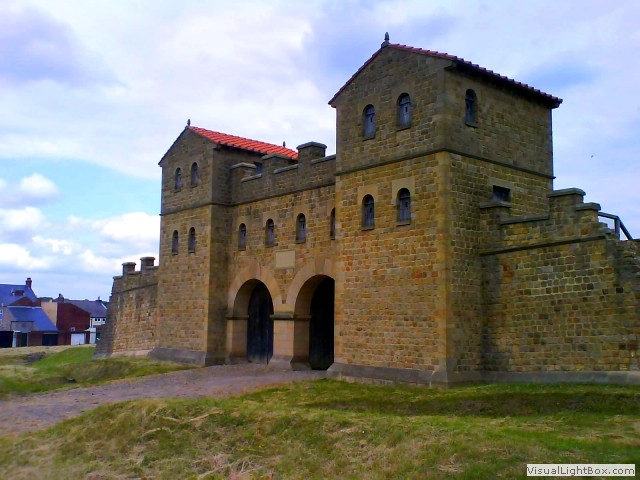 Arbeia guarded the main sea route to Hadrian's Wall, and was a key garrison and military
supply base to other forts along the Wall. A Roman gatehouse, barracks and
Commanding Officer's house have been reconstructed on their original foundations.
Arbeia guarded the main sea route to Hadrian's Wall, and was a key garrison and military
supply base to other forts along the Wall. A Roman gatehouse, barracks and
Commanding Officer's house have been reconstructed on their original foundations. -
Sunderland’s shipyards
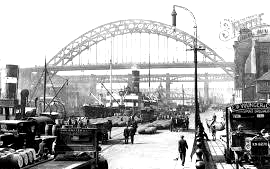 Noisy and smoky, Sunderland’s shipyards were once the most successful on the
planet, producing, at their peak, a quarter of all the ships in the entire World.
The National Glass Centre now stands on the River Wear, and was where the death knell
for shipbuilding in the town ended.
Noisy and smoky, Sunderland’s shipyards were once the most successful on the
planet, producing, at their peak, a quarter of all the ships in the entire World.
The National Glass Centre now stands on the River Wear, and was where the death knell
for shipbuilding in the town ended. -
The Penshaw Monument
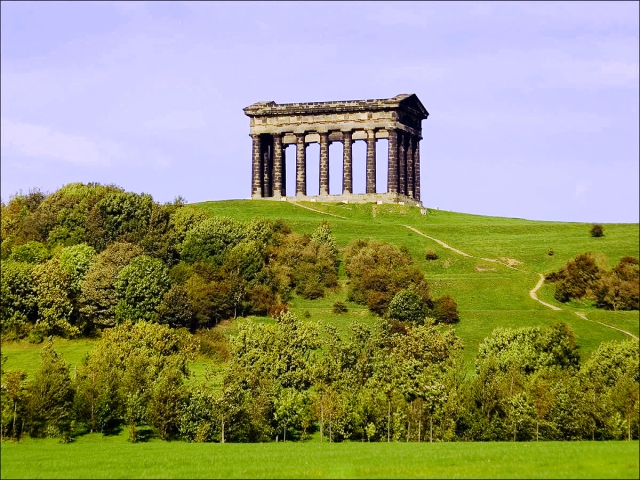 The Penshaw Monument, officially ‘The Earl of Durham's Monument’, was built in 1844 on
Penshaw Hill. The monument dominates the local landscape as a half-sized replica of the
Temple of Hephaestus in Athens.
The Penshaw Monument, officially ‘The Earl of Durham's Monument’, was built in 1844 on
Penshaw Hill. The monument dominates the local landscape as a half-sized replica of the
Temple of Hephaestus in Athens. -
The Mahogany Drift coal mine
 The Mahogany Drift coal mine at Beamish was a real mine, which originally opened
in 1855 and run for one hundred years. It re-opened as a tourist attraction in
1970, once inside the coal mine; it did not take long to imagine what conditions
must have been like for the miners. People were shorter in those days and
those that weren’t, ended up with either ‘bow legs’ or a curved spine. Miners often
had to work lying on their backs or sides while chipping away at the coal seam using hand tools.
They even had to buy their own tools, but by law, safety lamps had to be supplied by
the mine company and even though they provided less illumination than a candle, they were
compulsory to use because they were incapable of igniting firedamp.
The Mahogany Drift coal mine at Beamish was a real mine, which originally opened
in 1855 and run for one hundred years. It re-opened as a tourist attraction in
1970, once inside the coal mine; it did not take long to imagine what conditions
must have been like for the miners. People were shorter in those days and
those that weren’t, ended up with either ‘bow legs’ or a curved spine. Miners often
had to work lying on their backs or sides while chipping away at the coal seam using hand tools.
They even had to buy their own tools, but by law, safety lamps had to be supplied by
the mine company and even though they provided less illumination than a candle, they were
compulsory to use because they were incapable of igniting firedamp. -
Pockerley Old Hall
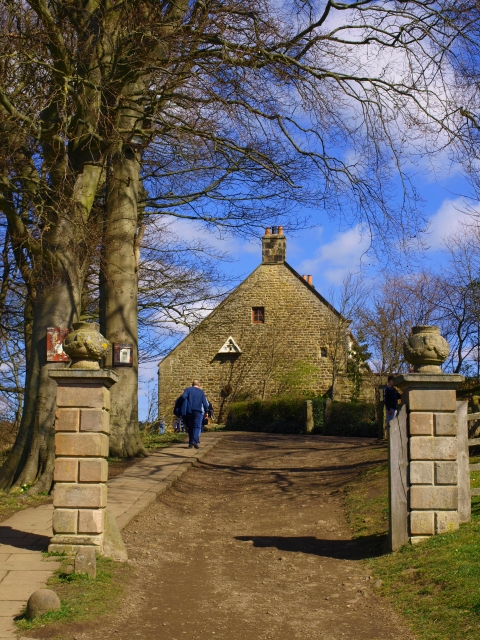 The Old Hall sits nestled amidst a dark copse of trees and is set very much apart from the
quaint little town – with all of its touristy hustle and bustle and jolly Edwardian
re-enactors. The hall has a remote, older feel to it, emphasised by its situation
overlooking the empty shell of a church and the old railway line below it.
The Old Hall sits nestled amidst a dark copse of trees and is set very much apart from the
quaint little town – with all of its touristy hustle and bustle and jolly Edwardian
re-enactors. The hall has a remote, older feel to it, emphasised by its situation
overlooking the empty shell of a church and the old railway line below it. -
Lest we forget- St Nicholas burial ground Durham
Private- James Arthur Cleckner- East Yorkshire Regiment- died April 16, 1941, Age 24. Able Seaman- Kenneth Aubin- Royal Navy- died July 12, 1944, Age 20. Private- T Davis- Durham Light Infantry- died October 14, 1915. Private- Joseph Bell- Durham Light Infantry- died September 17, 1917, Age 34. Serjeant Major- John William McCann- Royal Field Artillery- died September 13, 1919, Age 45. Corporal- William Henry Lofthouse- Northumberland Fusiliers- died July 5, 1916, Age 24.
-
Durham castle
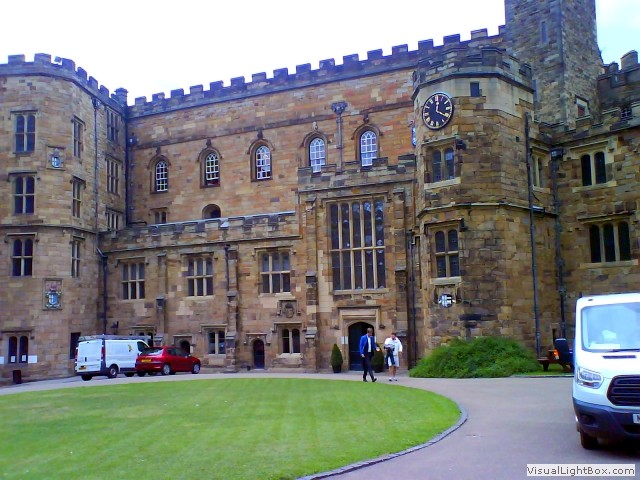 Durham Castle was originally built in the 11th century as a projection of the Norman
kings' power in the north of England. The castle has been wholly occupied since 1840
by University College, Durham. It’s worth a tour, and we only paid £3 because
some of the rooms were off limits.
Durham Castle was originally built in the 11th century as a projection of the Norman
kings' power in the north of England. The castle has been wholly occupied since 1840
by University College, Durham. It’s worth a tour, and we only paid £3 because
some of the rooms were off limits. -
The Rose Window- Durham Cathedral
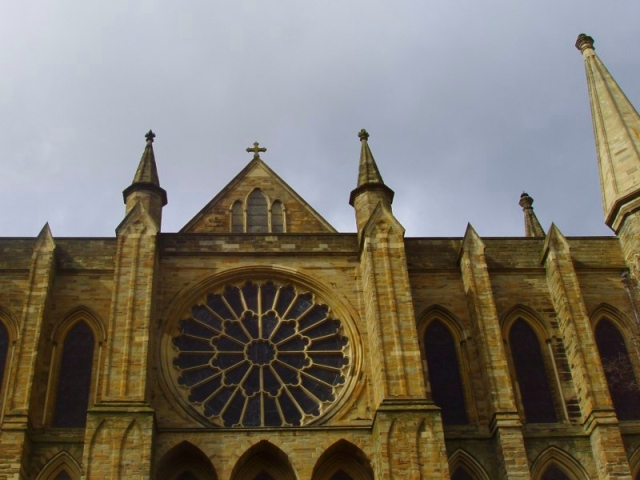 Originally glazed in the 15th century by Richard Pickering, the present glass
dates from the late nineteenth century, and depicts Christ surrounded by the
apostles, in turn surrounded by the 24 elders from the 'book of Revelation'.
Originally glazed in the 15th century by Richard Pickering, the present glass
dates from the late nineteenth century, and depicts Christ surrounded by the
apostles, in turn surrounded by the 24 elders from the 'book of Revelation'. -
Auckland Way Railway Path
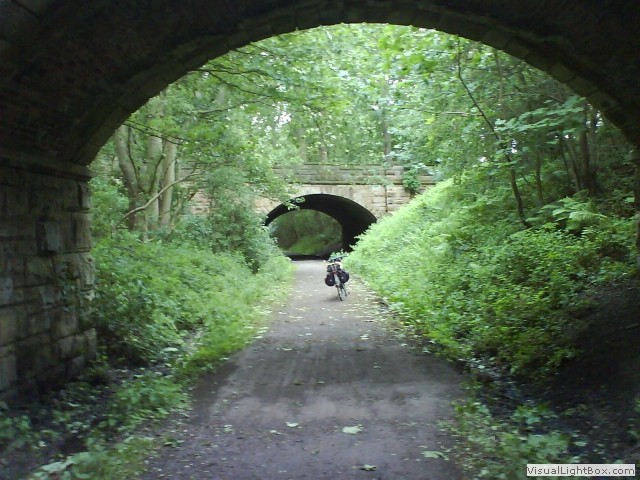 The Railway Path passes through countryside which was once part of the Bishop’s Park.
Bishop Lightfoot hated the railway so much, he would only give his consent for the use
of his land if a special 'double' bridge was built over the railway for his personal
use. On ‘Google’ maps the two bridges above are not attached to roads, just fields each side.
The Railway Path passes through countryside which was once part of the Bishop’s Park.
Bishop Lightfoot hated the railway so much, he would only give his consent for the use
of his land if a special 'double' bridge was built over the railway for his personal
use. On ‘Google’ maps the two bridges above are not attached to roads, just fields each side. -
Happy to be Geordie
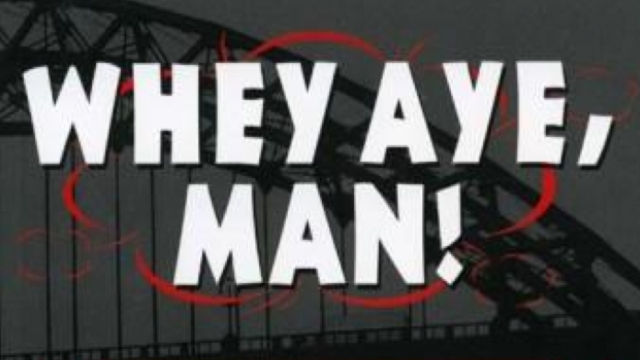 It's official, Newcastle is one of the happiest places to live in Europe (15th in 2016).
To get this accolade they conducted a European survey, and Geordies were voted the happiest
people in the UK, and were the most satisfied with where they lived. I still wouldn’t live there,
it’s too cold.
It's official, Newcastle is one of the happiest places to live in Europe (15th in 2016).
To get this accolade they conducted a European survey, and Geordies were voted the happiest
people in the UK, and were the most satisfied with where they lived. I still wouldn’t live there,
it’s too cold.

 The world's first passenger railway; the Stockton and Darlington Railway opened
in 1825 with a train hauled by Locomotion No 1 which took two hours to complete the
twelve mile journey from Shildon to Darlington.
The world's first passenger railway; the Stockton and Darlington Railway opened
in 1825 with a train hauled by Locomotion No 1 which took two hours to complete the
twelve mile journey from Shildon to Darlington. The Gemini Collection of Mining Art includes more than 420 works by prominent
local artists. The art shows what it felt like to work in the coalmines and shed
light on why some miners felt it necessary to paint the dark, clamorous,
claustrophobic, and arcane world of a coal mine.
The Gemini Collection of Mining Art includes more than 420 works by prominent
local artists. The art shows what it felt like to work in the coalmines and shed
light on why some miners felt it necessary to paint the dark, clamorous,
claustrophobic, and arcane world of a coal mine. Known from inscriptions on tablets, the garrison in this fort was a cavalry unit originally
recruited from central Spain accompanied at some point by a unit of cavalry originating
from the area we now know as Holland.
Known from inscriptions on tablets, the garrison in this fort was a cavalry unit originally
recruited from central Spain accompanied at some point by a unit of cavalry originating
from the area we now know as Holland. The present building is largely a 19th-century restoration carried out in the 1820s.
During the WW1 the castle was used as a hospital by convalescents from Newcastle
General Hospital. In 1939 it became the regimental headquarters for the Durham Light
Infantry, who erected a military camp of over 100 huts to the south of the village
during WW2. The Durham Light Infantry left the Castle in 1962.
The present building is largely a 19th-century restoration carried out in the 1820s.
During the WW1 the castle was used as a hospital by convalescents from Newcastle
General Hospital. In 1939 it became the regimental headquarters for the Durham Light
Infantry, who erected a military camp of over 100 huts to the south of the village
during WW2. The Durham Light Infantry left the Castle in 1962. The sky over Consett, had long been famous for its thick haze of red iron oxide
dust thrown up by the steelworks, as was the cloud of steam evaporating all around
the tall cooling towers, but the price for cleaner air was high. Amidst intense
debate and large demonstrations by workers and sympathizers, Consett Steel Works
was closed in 1980, leading to massive job losses, but the true reflection of unemployment and social
impact couldn’t be calculated because of all the support industries lost.
The sky over Consett, had long been famous for its thick haze of red iron oxide
dust thrown up by the steelworks, as was the cloud of steam evaporating all around
the tall cooling towers, but the price for cleaner air was high. Amidst intense
debate and large demonstrations by workers and sympathizers, Consett Steel Works
was closed in 1980, leading to massive job losses, but the true reflection of unemployment and social
impact couldn’t be calculated because of all the support industries lost. As the coal industry declined during the latter part of last the century, so too did Dunston
Staiths, the jetty eventually fell into serious disrepair. Though some reprieve came
when the National Garden Festival was held in Gateshead in 1990, some repairs were
done and it became a grade II listed structure.
As the coal industry declined during the latter part of last the century, so too did Dunston
Staiths, the jetty eventually fell into serious disrepair. Though some reprieve came
when the National Garden Festival was held in Gateshead in 1990, some repairs were
done and it became a grade II listed structure. In the 19th century, shipbuilding and heavy engineering were central to the
city's prosperity. The shipyards employed generations of families, today only one
small shipbuilder still exists. Swan Hunter was the biggest shipbuilder in Newcastle,
launching famous ships including the Mauretania, and the Carpathia in 1912 (which
braved icebergs to rescue the survivors of the Titanic). The city was a
powerhouse of the Industrial Revolution, by 1800 Tyneside was the third largest
producer of ships in Britain. In May 1993 the receivers were called in and job
losses of over 2,000 were announced at the Swan Hunter yards.
In the 19th century, shipbuilding and heavy engineering were central to the
city's prosperity. The shipyards employed generations of families, today only one
small shipbuilder still exists. Swan Hunter was the biggest shipbuilder in Newcastle,
launching famous ships including the Mauretania, and the Carpathia in 1912 (which
braved icebergs to rescue the survivors of the Titanic). The city was a
powerhouse of the Industrial Revolution, by 1800 Tyneside was the third largest
producer of ships in Britain. In May 1993 the receivers were called in and job
losses of over 2,000 were announced at the Swan Hunter yards.  The Priory was sacked by the Danes several times, despite fortification by the monks. Time has left behind its spiritual
scars and those brave enough to walk through the Castle and Priory after dark may
catch sight of the Black Monk, who is said to roam the grounds in his hooded robes. Even
in daylight it’s quite odd walking amongst the graves, and despite the spit of land being
open, you can clearly hear people speaking on the other side of the site.
The Priory was sacked by the Danes several times, despite fortification by the monks. Time has left behind its spiritual
scars and those brave enough to walk through the Castle and Priory after dark may
catch sight of the Black Monk, who is said to roam the grounds in his hooded robes. Even
in daylight it’s quite odd walking amongst the graves, and despite the spit of land being
open, you can clearly hear people speaking on the other side of the site.  Arbeia guarded the main sea route to Hadrian's Wall, and was a key garrison and military
supply base to other forts along the Wall. A Roman gatehouse, barracks and
Commanding Officer's house have been reconstructed on their original foundations.
Arbeia guarded the main sea route to Hadrian's Wall, and was a key garrison and military
supply base to other forts along the Wall. A Roman gatehouse, barracks and
Commanding Officer's house have been reconstructed on their original foundations. Noisy and smoky, Sunderland’s shipyards were once the most successful on the
planet, producing, at their peak, a quarter of all the ships in the entire World.
The National Glass Centre now stands on the River Wear, and was where the death knell
for shipbuilding in the town ended.
Noisy and smoky, Sunderland’s shipyards were once the most successful on the
planet, producing, at their peak, a quarter of all the ships in the entire World.
The National Glass Centre now stands on the River Wear, and was where the death knell
for shipbuilding in the town ended. The Penshaw Monument, officially ‘The Earl of Durham's Monument’, was built in 1844 on
Penshaw Hill. The monument dominates the local landscape as a half-sized replica of the
Temple of Hephaestus in Athens.
The Penshaw Monument, officially ‘The Earl of Durham's Monument’, was built in 1844 on
Penshaw Hill. The monument dominates the local landscape as a half-sized replica of the
Temple of Hephaestus in Athens. The Mahogany Drift coal mine at Beamish was a real mine, which originally opened
in 1855 and run for one hundred years. It re-opened as a tourist attraction in
1970, once inside the coal mine; it did not take long to imagine what conditions
must have been like for the miners. People were shorter in those days and
those that weren’t, ended up with either ‘bow legs’ or a curved spine. Miners often
had to work lying on their backs or sides while chipping away at the coal seam using hand tools.
They even had to buy their own tools, but by law, safety lamps had to be supplied by
the mine company and even though they provided less illumination than a candle, they were
compulsory to use because they were incapable of igniting firedamp.
The Mahogany Drift coal mine at Beamish was a real mine, which originally opened
in 1855 and run for one hundred years. It re-opened as a tourist attraction in
1970, once inside the coal mine; it did not take long to imagine what conditions
must have been like for the miners. People were shorter in those days and
those that weren’t, ended up with either ‘bow legs’ or a curved spine. Miners often
had to work lying on their backs or sides while chipping away at the coal seam using hand tools.
They even had to buy their own tools, but by law, safety lamps had to be supplied by
the mine company and even though they provided less illumination than a candle, they were
compulsory to use because they were incapable of igniting firedamp. The Old Hall sits nestled amidst a dark copse of trees and is set very much apart from the
quaint little town – with all of its touristy hustle and bustle and jolly Edwardian
re-enactors. The hall has a remote, older feel to it, emphasised by its situation
overlooking the empty shell of a church and the old railway line below it.
The Old Hall sits nestled amidst a dark copse of trees and is set very much apart from the
quaint little town – with all of its touristy hustle and bustle and jolly Edwardian
re-enactors. The hall has a remote, older feel to it, emphasised by its situation
overlooking the empty shell of a church and the old railway line below it. Durham Castle was originally built in the 11th century as a projection of the Norman
kings' power in the north of England. The castle has been wholly occupied since 1840
by University College, Durham. It’s worth a tour, and we only paid £3 because
some of the rooms were off limits.
Durham Castle was originally built in the 11th century as a projection of the Norman
kings' power in the north of England. The castle has been wholly occupied since 1840
by University College, Durham. It’s worth a tour, and we only paid £3 because
some of the rooms were off limits. Originally glazed in the 15th century by Richard Pickering, the present glass
dates from the late nineteenth century, and depicts Christ surrounded by the
apostles, in turn surrounded by the 24 elders from the 'book of Revelation'.
Originally glazed in the 15th century by Richard Pickering, the present glass
dates from the late nineteenth century, and depicts Christ surrounded by the
apostles, in turn surrounded by the 24 elders from the 'book of Revelation'. The Railway Path passes through countryside which was once part of the Bishop’s Park.
Bishop Lightfoot hated the railway so much, he would only give his consent for the use
of his land if a special 'double' bridge was built over the railway for his personal
use. On ‘Google’ maps the two bridges above are not attached to roads, just fields each side.
The Railway Path passes through countryside which was once part of the Bishop’s Park.
Bishop Lightfoot hated the railway so much, he would only give his consent for the use
of his land if a special 'double' bridge was built over the railway for his personal
use. On ‘Google’ maps the two bridges above are not attached to roads, just fields each side. It's official, Newcastle is one of the happiest places to live in Europe (15th in 2016).
To get this accolade they conducted a European survey, and Geordies were voted the happiest
people in the UK, and were the most satisfied with where they lived. I still wouldn’t live there,
it’s too cold.
It's official, Newcastle is one of the happiest places to live in Europe (15th in 2016).
To get this accolade they conducted a European survey, and Geordies were voted the happiest
people in the UK, and were the most satisfied with where they lived. I still wouldn’t live there,
it’s too cold.